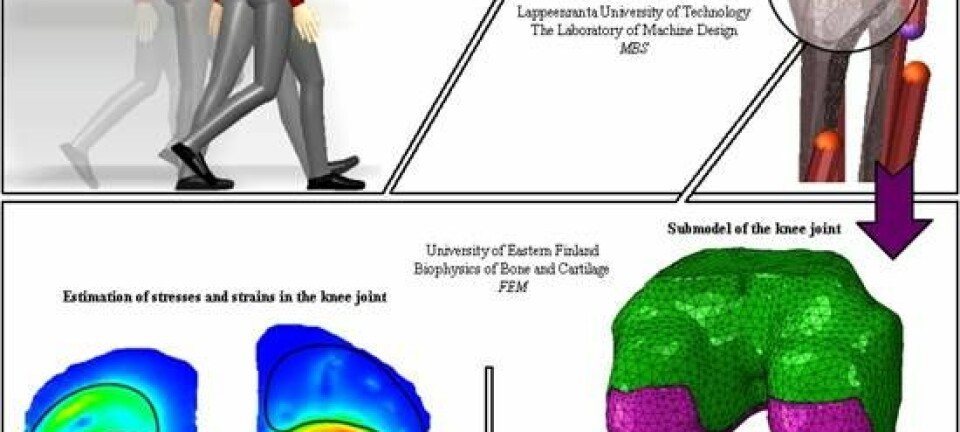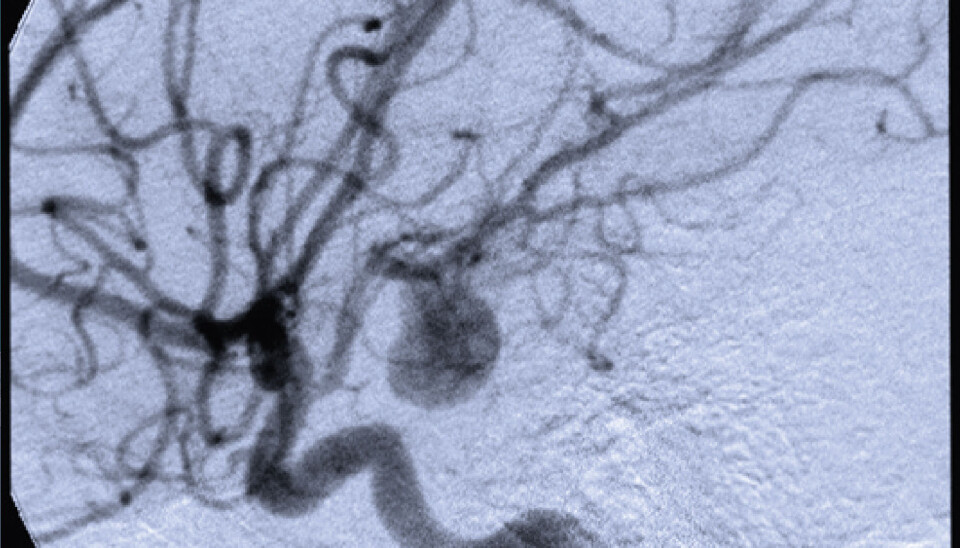
Simulations can foresee cerebral haemorrhage
Newly developed simulations are able tell us whether or not a brain aneurism needs to be treated. The lethal bulges can soon be discovered by listening to the eye.
Denne artikkelen er over ti år gammel og kan inneholde utdatert informasjon.
Each year 500 Norwegians are afflicted with acute cerebral haemorrhage caused by bursting aneurisms in one of the arteries of the brain. The death rate is high. Half of those who survive are permanently brain damaged.
Brain aneurisms afflict one in eighteen people during the course of their life. Most aneurisms are discovered by accident during a brain scan for some other reason. Only a minority of the aneurisms burst. Most are not treated.
Scientists at the Department of Informatics , University of Oslo and the Centre for Biomedical Computing at the Centre of Excellence, Simula, have used advanced simulations to find out which aneurisms should be treated.
"This research may be of great practical significance as it increases the knowledge about aneurisms and helps us assess the risk of an aneurism bursting", Professor Per Kristian Eide at the Department of Neurosurgery at Oslo University Hospital says.
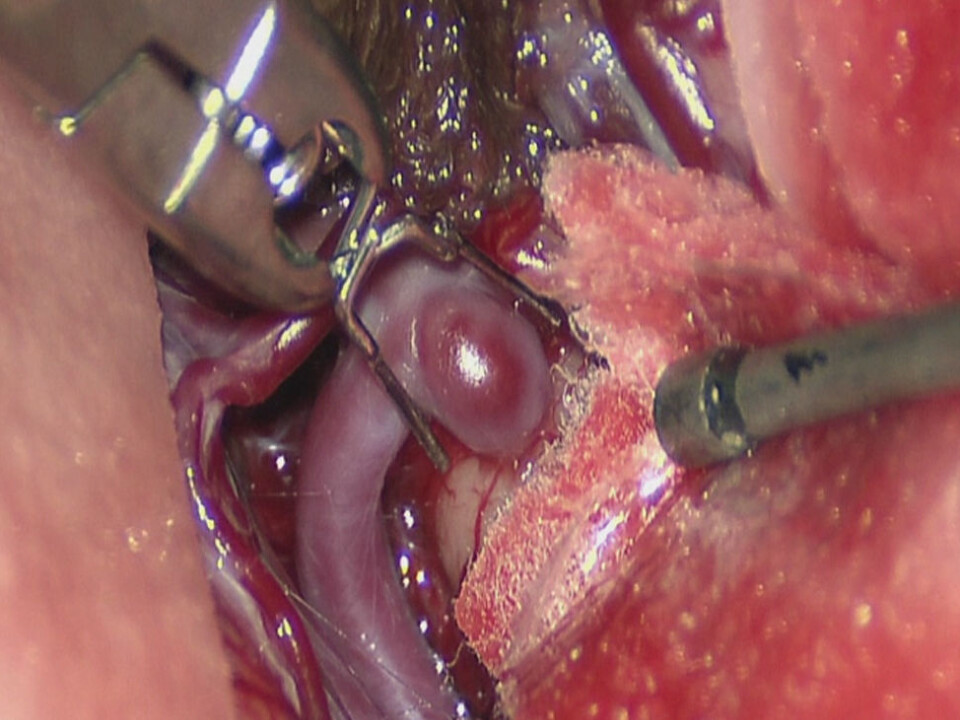
A brain aneurism can be compared to an inflated balloon. Most aneurisms develop close to the Circle of Willis where the blood vessels separate from each other. The Circle of Willis is the brain’s oval motorway circuit which secures the blood stream to the brain, despite obstacles such as blood clots and narrow passages. It is so ingeniously designed, that the blood stream even alters during intense thought activity. In fact, your brain alters by an entire ten percent when you read a book for eight seconds only.
Risky operation
Doctors need to examine and evaluate the likelihood of an aneurism bursting. A brain operation is a high risk procedure and there is often a danger of something going wrong.
A brain aneurism can be removed in two ways. The first is a surgical operation of the brain. The surgeon opens the cranium and attaches a clip to the aneurism. Many patients are too ill to endure the operation. If an aneurism bursts during the procedure, the result can be fatal.
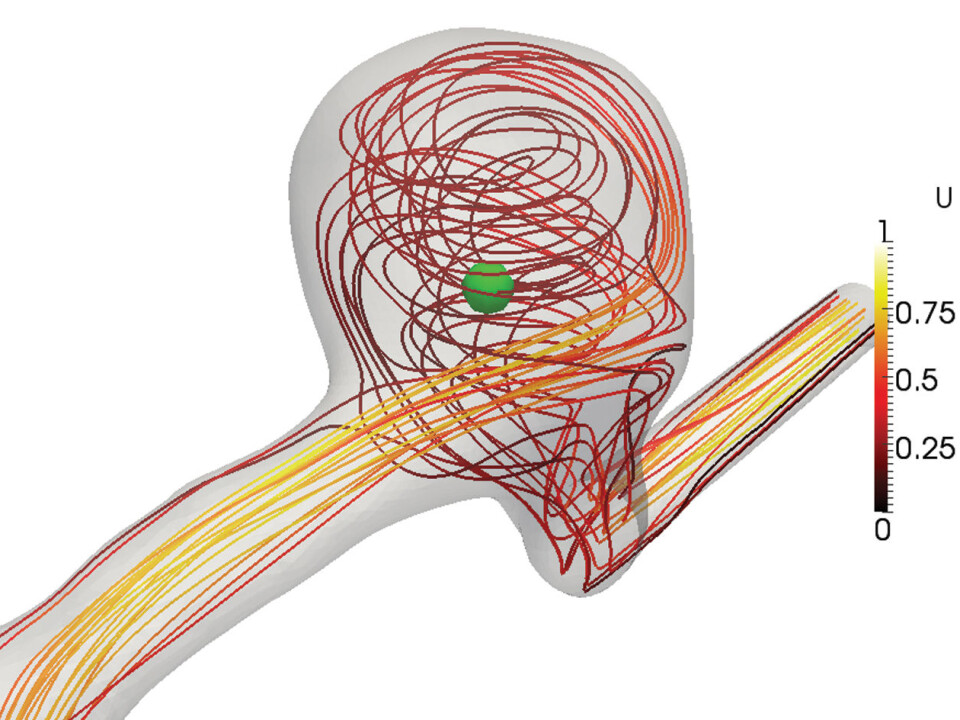
The second method is to fill the aneurism from the inside by leading a thin metal wire containing filling material through the aorta to the aneurism itself.
"Seeing as all brain procedures are deemed risky, it is important to find out whether or not an aneurism is likely to burst. We use simulations to find out if an operation is necessary," Associate Professor Kent-Andre Mardal at the Department of Informatics, University of Oslo says.
Blood turbulence discovered
Together with adjunct research scientist Kristian Valen-Sendstad, guest researcher Mikael Mortensen from the Norwegian Defence Research Establishment (FFI) and Professor Hans Petter Langtangen, Mardal has used mathematical simulations to study the cerebral blood stream and pressure in aneurisms and the main artery of the brain.
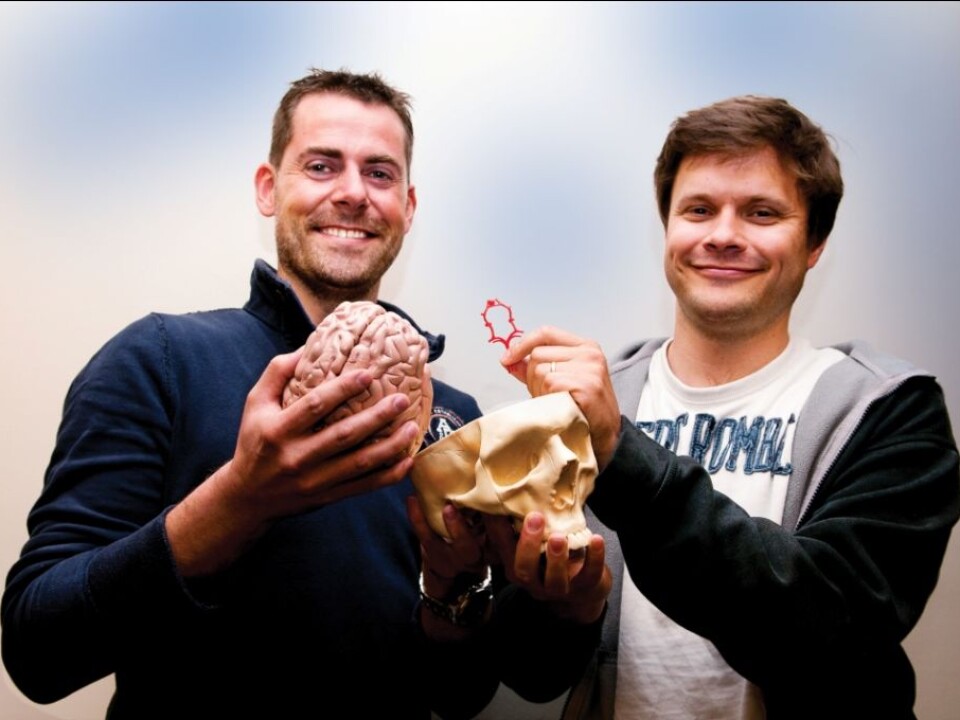
The question at hand has been whether or not turbulence occurs in blood vessels, i.e. a chaos of rapidly fluctuating streams that continuously change without any form of system.
"Everyone has told us no. This has been the common theory, even though there have been certain indications that turbulence in blood vessels actually can occur."
The four scientists have established that the cerebral blood stream of some patients may be both complicated and turbulent.
"Our estimations show that cells in blood vessels and aneurisms can endure much more stress than one initially thought. If blood is pumped at a straight angle in to the aneurism, the construction of the blood vessel wall is destroyed in such a way that it becomes thinner and more fragile. In the end it bursts. If blood is rather pumped up along the vessel wall, the pressure diminishes. This renders an operation unnecessary," Valen-Sendstad explains.
Turbulence alters the blood vessels
Turbulence determines the shape of the blood vessels. All blood vessels have three layers. The inner layer consists of the only cells in the blood vessel which are in direct contact with blood. The middle layer constitutes the strength of the blood vessel. The outer layer is elastic. The cells in the inner layer send signals to the two other layers on how they should react.
The inner cells place themselves in the same direction as the blood stream as long as the stream is stable. So far, all is well.
"When the cerebral blood stream is complicated, the inner cells place themselves in a chaotic pattern. The cells are thus stretched in different directions and give contradicting signals to the cells in the strong part of the blood vessel wall about how they should react to pressure. These cells subsequently start growing in an abnormal way. This is how an aneurism starts developing."
Or, to put it another way: The cells are accustomed to a pulse rate of 50 to 200 beats a minute. When the cerebral blood stream is chaotic, it is the equivalent to one hundred times a normal pulse. No wonder the cells subsequently cause havoc and behave accordingly.
The scientists simulated the tenacity along the inner cells of the blood vessel wall.
"We observed small disturbances in the blood stream next to aneurisms. This was turbulence. Turbulence occurs when the pressure of the blood stream is reduced after a heart attack. One hypothesis is that the blood stream has already been disturbed before the aneurism occurs and that rapid fluctuation in the stream’s pattern worsens the situation."
New mathematical methods
The calculations done at the Centre for Biomedical Computing have contributed to the development of new methods for simulating the cooperation between cerebral blood streams, blood vessel walls and blood cells. They can estimate both the tenacity and velocity at any given point of the blood stream. They can also apply simulations to study how turbulence occurs and disappears.
To carry out the simulations, the arterial Circle of Willis was divided into 5, 5 million tiny virtual pyramids. The scientists simulated 14 heartbeats and studied the alterations that occurred at every point of the blood circuit each 1/40 000 second. No wonder they used 5500 computer hours to reach their goal.
Simplified examination
It is easier to compare the condition of ill and well patients with simulation.
"Although you can’t treat aneurisms with simulations, what you learn from the simulations can improve the treatment of patients and prevent mistakes from being made during surgical procedures."
Kent-Andre Mardal is one of 17 test persons in the experiment. The scientists made a mathematical model of the blood circulation in his brain by doing an MR scan of his head and by measuring how the velocity changed in the two blood vessels when they put pressure on his carotid.
"There are so many individual and complex factors when it comes to brain aneurisms that it is necessary to examine many patients."
Listen to the eye
In 1970 the Canadian scientist Gary C. Ferguson tested turbulence in a glass model of the Circle of Willis. He discovered turbulence in a lower blood stream than the theory had called for earlier.
He also measured sound when he placed the clip on the blood vessel. There were rapid disturbances to be heard right after the point of highest velocity of the cerebral blood stream in the course of a single heartbeat.
When the Japanese scientist Yasushi Kurokawa examined aneurisms by placing a microphone on the eye in 1994, he discovered that the sound frequency via the eye was higher at a certain frequency in patients with aneurisms. His discovery did not attract a lot of attention.
With their simulations, the four Norwegian scientists have discovered the same as Kurokawa. They found small vibrations in the frequency directly after the blood stream was at its strongest.
"The sound was caused by turbulence."
No-one could explain the findings seeing as everyone thought that the blood stream in aneurisms was laminar, this being calm and predictable.
"We divided the simulations into smaller and smaller pyramids and were thus able to bring in more and more information. When the pyramids were larger, we did not observe any movement. However, after having divided the pyramids into smaller pyramids, we saw that the wall of the aneurism vibrated. During the course of one third of a heartbeat we actually observed ten pressure alterations in the aneurism. This is consistent with the discoveries of Ferguson and Kurokawa, and in accordance with turbulence theory."
The results of the experiments open up for the possibility of listening to the eye to hear which aneurisms are in risk of bursting. The scientists have already found the sound signal in 60 percent of the test persons.
"We have to do tests on many more before we can say anything more about our discoveries, so we’re not quite there yet when it comes to putting this method to clinical use," Valen-Sendstad says.
-------------------------
Read this article in Norwegian at Apollon
Translated by: Kathrine Torday Gulden







